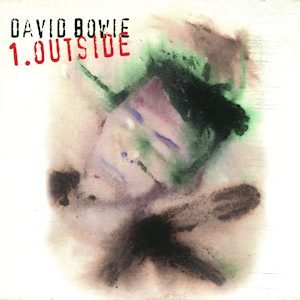Released in 1995, Outside marks a bold and complex chapter in David Bowie’s ever-shifting career. Known for his constant reinvention, Bowie had already explored glam rock, soul, electronic, and pop throughout the 70s and 80s. Yet with Outside, he chose a darker and more conceptual path. It was a return to the experimental ethos that defined albums like Low and Heroes, but with a stronger narrative backbone. This time, he ventured into the murky intersection of industrial rock, ambient soundscapes, and cyberpunk storytelling.
The album arrived during a time when alternative rock was dominating mainstream attention, and artists were beginning to re-embrace art rock sensibilities. Nine Inch Nails, for example, had helped popularize industrial music for a new generation. Bowie did not imitate this trend but instead absorbed its energy and filtered it through his own lens. Outside is not just an album of songs. It is a multimedia project wrapped in a dystopian story. It focuses on art, crime, and the erosion of identity in a future where technology and human expression collide.
Sonic Exploration

The sound of Outside is dense, chaotic, and meticulously crafted. It does not aim for easy listening or polished perfection. Instead, the production leans into disorientation, layering industrial textures with ambient passages and distorted rock elements. Co-produced by Bowie and David Richards, with creative input from Brian Eno, the album was built through a process of improvisation and reassembly. Musicians were encouraged to jam without a fixed structure, and these fragments were later edited into songs, giving the album its fractured, collage-like feel.
This method results in a sound that is both intricate and unsettling. The production creates a world that mirrors the album’s dystopian themes. Guitars snarl and grind through thick layers of noise, while electronics buzz and pulse like signals from a failing machine. The drums are often processed to feel distant or metallic, as if echoing through an underground space. Vocals are treated with effects that distort identity, matching the story’s exploration of fractured personalities.
The arrangements are rich with detail. Mike Garson’s piano work, full of avant-garde flourishes, adds an eerie and unpredictable edge. Reeves Gabrels’ guitar playing cuts through the mix with sharp, often jarring textures. Bowie himself delivers a wide range of vocal performances, shifting between characters and tones. On tracks like “The Hearts Filthy Lesson” and “I’m Deranged,” he layers vocals to create a sense of inner dialogue or narrative tension.
Genre Elements
In terms of genre, Outside draws from industrial rock, ambient music, art rock, and even hints of jazz and funk. Rather than confining itself to one style, the album fuses these elements into something deeply personal and forward-looking. It reflects the influence of 90s industrial and electronic movements, but it never feels derivative. Bowie was not chasing trends. He was absorbing them, reshaping them, and projecting them into his own artistic language.
Lyrical Analysis

At the heart of Outside lies a tangled web of themes: the commodification of violence, the decay of meaning in a hyper-mediated world, and the blurred line between creation and destruction. Bowie crafts a dystopian narrative where murder is seen as artistic expression, and where individuals lose their identities in a society obsessed with spectacle. This is not a concept album in the traditional sense, but rather a fragmented series of journal entries, character monologues, and cryptic observations that form a loose but provocative storyline.
The album’s lyrics are layered and often cryptic. Bowie adopts multiple personas—most notably Detective Nathan Adler, but also suspects and witnesses from the “art-crime” investigation. These shifting perspectives give the album a theatrical quality, as if the listener is flipping through a disjointed case file. Songs like “The Hearts Filthy Lesson” and “Hallo Spaceboy” mix paranoia with apocalyptic imagery, suggesting a world on the brink of collapse, both morally and technologically.
Recurring motifs appear throughout. There’s the repeated image of mutilated or disfigured bodies, used not for shock value, but to comment on the way art and media sensationalize suffering. There’s also a consistent sense of fragmentation—both linguistic and emotional. Bowie’s use of cut-up lyrics, inspired by William S. Burroughs, results in lines that feel jumbled or surreal. This technique reflects the disorientation of the characters and the broader themes of identity loss and artificiality.
Emotional Impact
Emotionally, the lyrics do not aim to comfort. Instead, they provoke unease and contemplation. There are moments of empathy—such as the tragic introspection in “Wishful Beginnings”—but they are often buried under layers of irony or detachment. Bowie challenges the listener to question what is real, what is performance, and what lies beneath the surface. It’s a lyrical experience that rewards multiple listens, not because it offers answers, but because it keeps unearthing new layers of meaning.
Cohesion and Flow

Outside is an ambitious work, and its cohesion stems more from its immersive atmosphere and recurring motifs than from traditional song sequencing. The album unfolds like a digital diary—fragmented, nonlinear, and intentionally disorienting. Tracks often bleed into each other through ambient interludes and spoken-word segments, which act as connective tissue between the more structured songs. These transitions help to maintain a sense of continuity, even as the music shifts in tone and tempo.
The track progression resists a clear beginning, middle, and end. Instead, it circles around its themes like a psychological spiral. Early songs such as “Leon Takes Us Outside” and “The Hearts Filthy Lesson” set the scene with bleak imagery and jittery energy. As the album moves through pieces like “A Small Plot of Land” and “No Control,” it descends deeper into introspection and emotional ambiguity. By the time it reaches “Strangers When We Meet,” the mood softens slightly, offering a sense of closure that feels tentative rather than conclusive.
Despite its sprawling length and dense concept, Outside maintains strong thematic consistency. The album rarely strays from its central focus on art, identity, and moral decay. Even the more musically accessible tracks like “Hallo Spaceboy” are laced with the same sense of unease and philosophical questioning that define the darker, more experimental cuts. While some listeners may find the spoken interludes or ambient passages challenging, they serve the larger purpose of reinforcing the album’s conceptual depth.
Stylistically, the album holds together through its commitment to a specific sonic palette—gritty electronics, fractured rhythms, and expressionistic performances. The consistent use of character voices and narrative fragments gives it the feel of a theatrical score rather than a traditional rock album. It’s this unity of purpose, rather than strict linearity, that makes Outside feel whole.
Standout Tracks and Moments
While Outside thrives as a conceptual whole, several tracks shine on their own due to their distinct sound, lyrical sharpness, or emotional depth.
The Hearts Filthy Lesson
One of the most immediate is “The Hearts Filthy Lesson.” Driven by clattering percussion and snarling guitars, the track captures the album’s industrial edge and sets the tone for its themes of artistic mutilation and ritualistic violence. Its dissonance is deliberate, mirroring the chaotic world the album builds.
Hallo Spaceboy
“Hallo Spaceboy” is another highlight. With its relentless energy and pounding electronic rhythms, it bridges Bowie’s past and present. The nod to Major Tom in the lyrics recontextualizes a beloved character in a darker, more alienated frame. It’s a track that both echoes and subverts his earlier work, showing how Bowie continuously reshaped his own mythology.
A Small Plot of Land
On the more introspective side, “A Small Plot of Land” stands out for its eerie, jazz-inflected arrangement and unsettling vocal delivery. Mike Garson’s avant-garde piano lines unravel beneath Bowie’s fragmented lyrics, capturing a deep sense of dread and emotional dislocation. It’s one of the most experimental pieces on the album, yet also one of the most affecting.
Strangers When We Meet
“Strangers When We Meet” offers a stark contrast. Originally released earlier in a different form, this version acts as an emotional coda. Its melodic clarity and romantic melancholy provide a rare moment of connection, reminding the listener of the human cost buried beneath the album’s abstraction. It does not resolve the story, but it gives the listener a glimpse of something tender within the chaos.
Memorable moments
Memorable moments abound throughout the record. The spoken-word segments—particularly “Ramona A. Stone/I Am with Name”—blur the lines between character monologue and poetry. These vignettes don’t just fill in narrative gaps. They highlight Bowie’s flair for performance and his willingness to use voice as an instrument of distortion and disguise. Another striking moment is the shifting, ghostlike layering of vocals in “I’m Deranged,” where the repetition of the phrase “And it’s the angels that count” becomes a haunting refrain.
Artistic Contribution and Innovation

Outside stands as one of David Bowie’s most conceptually daring works, carving out a unique space not only within his own catalog but also within the broader landscape of 1990s music. Released during a time when grunge and Britpop were dominating the charts, the album rejected conventional trends in favor of avant-garde storytelling and genre fusion. Rather than chasing commercial appeal, Bowie aligned himself with the experimental edge of industrial and electronic music, absorbing the aesthetics of artists like Nine Inch Nails while reshaping them through his own visionary lens.
In the context of genre, Outside operates as a hybrid. It sits at the crossroads of industrial rock, ambient, art rock, and experimental jazz, without fully committing to any single tradition. This genre-blurring approach was not entirely new for Bowie—his Berlin Trilogy had already laid the groundwork—but Outside took it further by embedding its sound within a sprawling narrative framework. The result is an album that defies easy categorization. It is as much a sound installation as it is a record.
Innovation
One of the album’s most innovative qualities lies in its construction. Much of it was born from improvisational sessions guided by chance and collage techniques. Bowie and Brian Eno revived the “Oblique Strategies” method to encourage spontaneity and break creative habits. Lyrics were partially created using the Verbasizer, a software tool that randomized text input to spark unexpected combinations. These techniques infused the album with a sense of unpredictability and layered meaning that feels both chaotic and intentional.
Thematically, Outside pushed boundaries in how a rock album could engage with narrative and concept. It tackled questions of art’s value, the ethics of performance, and the role of media in shaping identity—all within a fictional, dystopian framework that mirrored real cultural anxieties about the digital future. While not universally embraced upon release, the album has since been recognized as ahead of its time, prefiguring later explorations of transhumanism and virtual identity in music and art.
Closing Thoughts

Outside is an album that dares to alienate in order to provoke. Its strengths lie in its ambition, atmosphere, and refusal to play by the rules. Bowie plunges deep into a dystopian narrative without offering easy resolutions or commercial comforts. The production is immersive and textured, the performances are fearless, and the lyrical themes are rich with philosophical and cultural resonance. It is a project that demands engagement, inviting listeners to decode its cryptic language and inhabit its eerie, fractured world.
That said, Outside is not without its challenges. Its length and complexity can feel overwhelming, especially for those expecting traditional song structures or clear storytelling. Some may find the spoken-word interludes disruptive, while others might be drawn in by their theatrical flair. The album’s commitment to fragmentation is both its greatest strength and its most divisive feature.
As a work of art, Outside is a vital entry in Bowie’s discography. It marked a return to experimental form and reaffirmed his role as a pioneer willing to take risks long after his commercial peak. In hindsight, it bridges the avant-garde spirit of his Berlin Trilogy with the digital anxieties of the modern era, making it more relevant now than when it was first released.
Official Rating: 8/10
This score reflects the album’s bold vision and lasting impact. It may not offer the immediate satisfaction of Bowie’s more accessible works, but its depth and innovation reward those who are willing to go beyond the surface. Outside is a challenging listen, but for those open to its strange, shadowy universe, it remains one of Bowie’s most compelling artistic statements.
